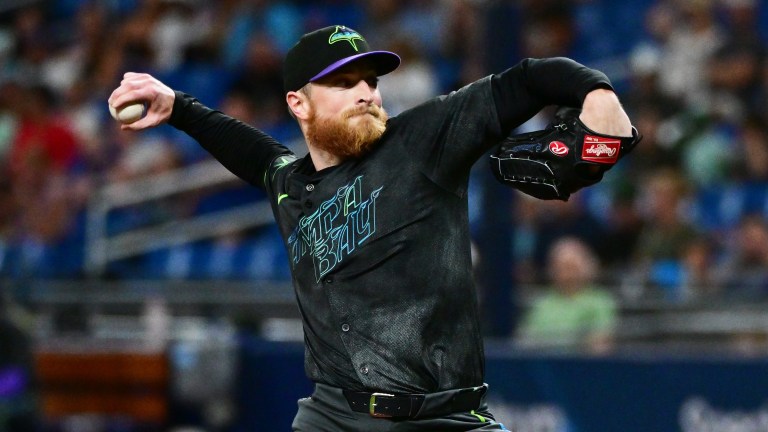The Rays Extended the Most Fascinating Pitcher in Baseball
Drew Rasmussen will be the most fascinating pitcher in baseball in 2025. Skeptical? Give me a chance to convince you.

Drew Rasmussen will be the most fascinating pitcher in baseball in 2025. Skeptical? Give me a chance to convince you.
On Tuesday, the Tampa Bay Rays signed Rasmussen to a two-year, $8.5 million extension, buying out both of his remaining arbitration years. He’ll receive a $500K signing bonus, a $2 million salary in 2025, and a $5.5 million salary in 2026.
In exchange for (essentially) granting Rasmussen his 2026 arbitration salary a year early, the Rays have given themselves an $8 million team option for his services in 2027 (with a $500K opt-out). The value of that option could increase to as much as $20 million if Rasmussen stays healthy over the next two years and pitches a full season in 2026.
So, why were the Rays eager to gain an extra year of control over a pitcher who has thrown fewer than 75 innings in the last two years combined?
It’s simple. Whenever the 29-year-old righty has been able to take the mound throughout his four-year tenure with Tampa Bay, he has looked like one of the very best pitchers in baseball.
Ra-Ra-Rasmussen
I’d like to play a quick game of Guess the Mystery Pitcher. Don’t waste too much time trying to figure this one out; it’s largely rhetorical, and it’s supposed to be hard.
- Pitcher A: 17-10, 253.0 IP, 251 K, 2.70 ERA, 2.91 FIP, 7.3 fWAR, 6.7 bWAR
- Pitcher B: 19-11, 278.1 IP, 255 K, 2.72 ERA, 2.86 FIP, 6.8 fWAR, 6.7 bWAR
Pitcher A is C.C. Sabathia in 2008. Sabathia is likely to be named a first-ballot Hall of Famer later this month. His 2008 season was arguably the best of his career.
Pitcher B is Drew Rasmussen with the Tampa Bay Rays from 2021-24.
Holy shit.
For many, many reasons, Rasmussen is not Sabathia. The latter was the ultimate workhorse of his generation. The former has long struggled to stay on the field. Still, this comparison illustrates just how phenomenally Rasmussen has pitched when healthy.
Rasmussen threw his first pitch for the Rays on June 19, 2021. From then on, his 2.72 ERA ranks third among all pitchers (min. 250 IP). His 70 ERA-, which is adjusted for stadium effects and scaled to league average, ranks seventh. His 2.86 FIP ranks fourth.
The Statcast numbers paint a similar picture. Since Rasmussen made his Rays debut, 170 pitchers have thrown at least 250 innings. Only one – elite closer Emmanuel Clase – has a higher Run Value per 100 pitches. Only 11 have a lower expected ERA.
| Pitcher | ERA | ERA- | FIP | RV/100 | xwOBA |
|---|---|---|---|---|---|
| Drew Rasmussen | 2.74 | 70 | 2.86 | 1.3 | .279 |
| League Average | 4.17 | 100 | 4.17 | 0.0 | .314 |
PitchingBot and Stuff+, two of the most prominent, publically available pitch modeling systems, are equally high on Rasmussen. These are metrics that evaluate pitch quality rather than results.
According to PitchingBot’s botERA (expected run value converted to the traditional ERA scale), Rasmussen ranks second among all pitchers (min. 250 IP), once again only trailing Clase:
Top Five Pitchers by botERA (June 19, 2021 to Present)
| Pitcher | botERA |
|---|---|
| Emmanuel Clase | 2.25 |
| Drew Rasmussen | 2.69 |
| Zack Wheeler | 2.70 |
| Julio Urías | 2.91 |
| Sandy Alcantara | 2.95 |
Meanwhile, according to Pitching+, an overall model from the Stuff+ family that considers physical pitch characteristics, location, and context, Rasmussen ranks 10th:
Top 10 Pitchers by Pitching+ (June 19, 2021 to Present)
| Name | Pitching+ |
|---|---|
| Emmanuel Clase | 115 |
| Spencer Strider | 111 |
| Griffin Jax | 110 |
| Gerrit Cole | 109 |
| Brandon Woodruff | 109 |
| Zack Wheeler | 109 |
| Julio Urías | 108 |
| Sandy Alcantara | 108 |
| Tyler Glasnow | 108 |
| Drew Rasmussen | 108 |
Whether you’re looking at surface-level stats, underlying numbers, or pitch data, it all points to the same conclusion.
Admittedly, these stats come from a relatively small sample of innings. Rasmussen has spent significant time on the IL in recent years, only tossing 278.1 frames for the Rays. That’s equivalent to roughly one and a half full seasons. Twenty-two pitchers have thrown more than twice as many innings in the same period of time.
Yet, that small sample is all we have to work with – and everything Rasmussen has done in that small sample tells us he can be an elite talent on the mound.
Completing the Comeback
It’s not just Rasmussen’s talent that makes him so fascinating. In 2025, he’ll be attempting to make history.
I wrote about Rasmussen’s incredible comeback efforts last summer. He is already the youngest pitcher ever to get back on a major league mound after three UCL surgeries.
Now, he’s hoping to become the first pitcher to return from his third UCL surgery and play a full season as a starting pitcher. He came off the IL last August but stuck to a bullpen/opener role down the stretch.
However, he will look to return to the Rays rotation this spring.
If Rasmussen can pull it off, he will represent a new frontier in elbow reconstruction. He will offer newfound hope to young pitchers amidst an epidemic of UCL injuries.
All he needs to do to accomplish that is stay healthy and pitch well enough to stick in the rotation.
Perhaps he’ll do so much more.
On a pitch-by-pitch, batter-by-batter, and inning-by-inning basis, Rasmussen has been one of the most dominant pitchers in baseball since he first suited up for Tampa Bay.
Take a look at the top 15 pitchers in FanGraphs WAR per 162 IP in that time. It’s a list of aces, with Rasmussen right there in the middle:
Top 15 Pitchers by fWAR per 162 IP (June 19, 2021 to Present)
| Pitcher | fWAR per 162 IP |
|---|---|
| Spencer Strider | 5.0 |
| Emmanuel Clase | 4.7 |
| Zack Wheeler | 4.7 |
| Chris Sale | 4.7 |
| Tyler Glasnow | 4.5 |
| Tarik Skubal | 4.3 |
| Shohei Ohtani | 4.2 |
| Blake Snell | 4.2 |
| Drew Rasmussen | 3.9 |
| Kevin Gausman | 3.9 |
| Max Fried | 3.9 |
| Dylan Cease | 3.8 |
| Sonny Gray | 3.8 |
| Max Scherzer | 3.8 |
| Justin Verlander | 3.8 |
Rasmussen doesn’t have to do much to be the most successful pitcher to ever return from three UCL surgeries. Even a mediocre season would be enough for him to make history.
But what if he has an amazing season?
Drew Rasmussen has always been an exceptional talent. Injuries have always held him back. He was an early selection in the 2017 draft but did not sign. After undergoing Tommy John in his senior year at Oregan State, he fell to the sixth round in 2018.
Injury concerns and bullpen risk kept him from ever being a top prospect during his time in the minor leagues. Since then, injuries have prevented him from reaching his full potential at the big league level.
Yet, Rasmussen is blessed with a pair of high-velocity fastballs, an unusual (and effective) cutter, and well-above-average command – all the tools he needs to thrive. We know how dominant he can look at his best.
Now, it’s time to see if he can maintain that level of dominance while pulling off an unprecedented comeback. It’s going to be fascinating to watch him try.
